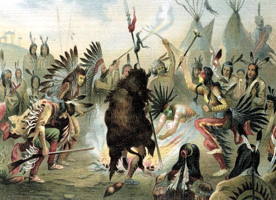
|
The Society of Folk Dance Historians (SFDH)
Native American Dances
[
Home |
About |
Encyclopedia | CLICK AN IMAGE TO ENLARGE |
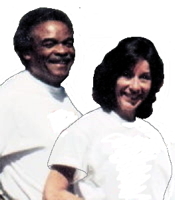
|
WAR DANCES
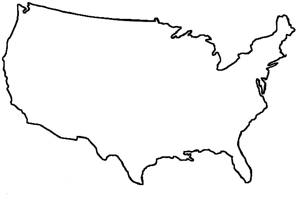 Native American War Dances, originally performed during victory celebrations after the men of the tribe returned from battle, are now performed as social dances. This is the predominant dance style seen at powwows. The dances are done to war dance songs, sung in vocables, with the head singer initiating the song and other singers joining as a chorus. the structure of these songs, AABCDBCD, may be repeated several times during the course of a dance that lasts up to ten minutes. The song structure is terraced descending, beginning at a higer pitch and gradually progressing to a lower one. The drum rhythm alternates accented and unaccented beats in duple meter. During the accented beats, the dancers honor the drum by increasing knee flexion, bowing their heads, or turning quickly. It is critically important that the dancers know the song well so that they are able to stop exactly on the last drum beat of the song.
Native American War Dances, originally performed during victory celebrations after the men of the tribe returned from battle, are now performed as social dances. This is the predominant dance style seen at powwows. The dances are done to war dance songs, sung in vocables, with the head singer initiating the song and other singers joining as a chorus. the structure of these songs, AABCDBCD, may be repeated several times during the course of a dance that lasts up to ten minutes. The song structure is terraced descending, beginning at a higer pitch and gradually progressing to a lower one. The drum rhythm alternates accented and unaccented beats in duple meter. During the accented beats, the dancers honor the drum by increasing knee flexion, bowing their heads, or turning quickly. It is critically important that the dancers know the song well so that they are able to stop exactly on the last drum beat of the song.
Women's Styles
Men's and women's War Dance styles differ. The women's traditional style is generally a dignified walk clockwise around the drum or a gentle pulsing in place at the periphery of the dance area. In the walking style, shoulders are tangent to the drum and in the pulsing style the chest faces the drum. Regardless of style, the stance maintained is narrow and the body is held erect except on the hard beats of the drum, when the torso is leaned forward and the head bent, to honor the drum. The body generally remains vertical, and the trunk moves as a single unit.
The footwork in the Northern and Southern traditional women's style differs in rhythm and in the flexion of the knee. In Northern style, the ball of the foot lightly touches the ground on the accented beat of the drum and on the unaccented beat, the heel moves slightly down and up before the whole foot is put down to step. Weight shifts continually forward. In the Southern Plains traditional style, the ball of the foot lightly touches the ground on the accented beat of the drum and the rhythm is more syncopated. In both styles, the stepping pattern is light and direct.
Women's Fancy Shawl style dance is seen most often during the dance contests. Overall, this style is similar to the Northern and Southern styles, but footwork and use of space differ. Knees are flexed and elbows are flexed and held away from the body, and there are many arm gestures used. The dancer shifts weight on every beat of the drum, and the speed of the drumbeat is accelerated. The stepping pattern includes variations on hops, hopping turns, side steps and back steps, and there is a great deal of changing of direction.
The men's Northern Traditional Dance style celebrates the role of the traditional warrior or hunter, and the gestures used often imitate combat or hunting movements. The torso tilts forward, with the head and trunk held forward and high, functioning as a single unit. Knees and hips are flexed at sharp angles, while elbows are flexed and held close to the body. The basic movement pattern is that of the flexion and extension. Footwork basically follows a stepping pattern, with the ball of one foot digging into the ground as the foot arches on the accented beat of the drum, followed by the heel rebounding and then touching the ground on the unaccented drum beat, as weight is shifted. Strong, sudden combinations of movement are one of the hallmarks of the style.
Men's Southern Straight Dance style evolved from tribal warrior tradition and conveys pride and dignity. The head and trunk function as a single unit, and the hips flex sharply as the dancers move in an S-curve path. Movements of the head are directional while movements of the body tend to be bilateral and symmetrical. Footwork is a basic stepping pattern with the ball of the foot digging into the ground on the accented drum beat, followed by a heel rebound down and up and then stepping on the whole foot on the unaccented beat. Props are always used – a straight dance stick in one hand, and usually a feather fan in the other. On the accented drum beat, the dancer touches one end of the dance stick to the ground, tilts his torso toward it, and follows an S-shaped path around the stick.
Men's Fancy Dance style is a very fast style of war dancing that involves more intricate footwork than other men's dance styles. The dancer moves on every beat of the drum, shifting his weight in the direction of the new supporting foot. He tends to revolve around his own axis in a limited space. In the basic foot movement, the heel rebound of the Straight Dance styles becomes a hop. Improvisational steps include hopping crossovers, side steps, back steps, pivots, and split-leg jumps.
ROUND DANCES
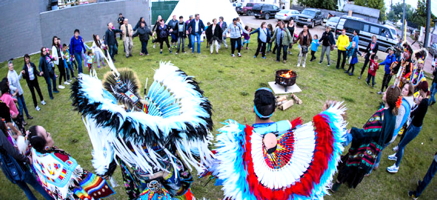 Round Dances, usually done at the beginning of a powwow session, are social dances for both men and women. However, the sexes tend to dance in separate small groupings, forming short arcs facing the drum. All groups move clockwise around the drum in relaxed posture, with feet parallel. Footwork is timed to the drumbeat, and is basically a side-together-side step movement. As the dancers move, their arms swing gently forward and backward. All try to dance in unison.
Round Dances, usually done at the beginning of a powwow session, are social dances for both men and women. However, the sexes tend to dance in separate small groupings, forming short arcs facing the drum. All groups move clockwise around the drum in relaxed posture, with feet parallel. Footwork is timed to the drumbeat, and is basically a side-together-side step movement. As the dancers move, their arms swing gently forward and backward. All try to dance in unison.
THE SNAKE DANCE
 The Snake Dance, another social dance, is led by two men, one serving as the head dancer and the other as the tail dancer. All dancers line up singly behind the head dancer and the tail dancer ends the line. The dancers move in a trot step with their shoulders tangent to the drum. All move clockwise following the lead of the head dancer. When the head dancer chooses, he reverses the direction of the path by lifting his hand overhead and turning around. At this point, the tail dancer becomes the initiator of the dance, and all follow his lead.
The Snake Dance, another social dance, is led by two men, one serving as the head dancer and the other as the tail dancer. All dancers line up singly behind the head dancer and the tail dancer ends the line. The dancers move in a trot step with their shoulders tangent to the drum. All move clockwise following the lead of the head dancer. When the head dancer chooses, he reverses the direction of the path by lifting his hand overhead and turning around. At this point, the tail dancer becomes the initiator of the dance, and all follow his lead.
THE BUFFALO DANCE
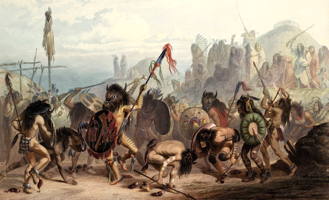 Done to honor the buffalo, the staff of life for Plains Native Americans, men and women both participate in the Buffalo Dance. The song consists of two distinct alternating rhythms, a series of hard beats alternate3d with a drum roll. The change in the dancers' movement patterns coordinates with the changes in the drum beat. When the rhythm changes to the drum roll, the dancers walk several small steps clockwise with shoulders tangent to the drum, imitating the haphazard grazing of buffalo herds on the plains.
Done to honor the buffalo, the staff of life for Plains Native Americans, men and women both participate in the Buffalo Dance. The song consists of two distinct alternating rhythms, a series of hard beats alternate3d with a drum roll. The change in the dancers' movement patterns coordinates with the changes in the drum beat. When the rhythm changes to the drum roll, the dancers walk several small steps clockwise with shoulders tangent to the drum, imitating the haphazard grazing of buffalo herds on the plains.
THE TWO-STEP
 The Two-Step is an exuberant Southern Plains Native American couple dance in which women choose their dance partners. Woman may choose whomever they wish, and, if a man refuses to dance with a woman, he must pay her so as not to dishonor her. The leaders of the dance are the head male and female dancers. All join hands in the forward skater's position and form a double-file semicircle behind the head couple. To begin the dance, the head couple moves clockwise with the basic step of the dance (walk forward on left foot on drum beat one, close with right foot on beat two; repeat for measure two; on measure three move left foot backward on beat one, and move right foot forward on beat two). As the dance progresses, the head dancers initiate any of a number of variations on this basic step. Toward the end of the song, the tempo accelerates and the rhythm changes. At that point, all dancers join hands, forming a large single circle around the drum, and all trot clockwise (or do a grapevine step). The head dancer moves the circle in and out around the drummer, honoring the drum by cheering as they move forward.
The Two-Step is an exuberant Southern Plains Native American couple dance in which women choose their dance partners. Woman may choose whomever they wish, and, if a man refuses to dance with a woman, he must pay her so as not to dishonor her. The leaders of the dance are the head male and female dancers. All join hands in the forward skater's position and form a double-file semicircle behind the head couple. To begin the dance, the head couple moves clockwise with the basic step of the dance (walk forward on left foot on drum beat one, close with right foot on beat two; repeat for measure two; on measure three move left foot backward on beat one, and move right foot forward on beat two). As the dance progresses, the head dancers initiate any of a number of variations on this basic step. Toward the end of the song, the tempo accelerates and the rhythm changes. At that point, all dancers join hands, forming a large single circle around the drum, and all trot clockwise (or do a grapevine step). The head dancer moves the circle in and out around the drummer, honoring the drum by cheering as they move forward.
GOURD DANCES
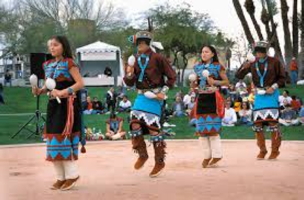 Gourd Dances, originally a tradition of the Kiowa warrior societies, are currently limited to male dancers, who hold a gourd rattle in the right hand that is shaken rhythmically with the drum beat. A feather fan is held in the left hand. During the dance, the upper body is held vertical except on the hard beats of the drum, when it leans forward. The trunk moves as a single unit. At the beginning of the dance, all remain seated and shake their rattles in time with the music. All rise during the repeat of the second song, and pulse in place by flexing and extending their knees. In the middle of the second song, the dancers lean forward with their torsos to honor the drum and then proceed to walk with small steps toward the drum, stepping on each accented beat. As the drumbeat softens, the dancers continue to walk in place or proceed clockwise around the drum until the song ends. The end of the song is signaled by a drum roll, at which time the dancers yell and shake their gourds vigorously.
Gourd Dances, originally a tradition of the Kiowa warrior societies, are currently limited to male dancers, who hold a gourd rattle in the right hand that is shaken rhythmically with the drum beat. A feather fan is held in the left hand. During the dance, the upper body is held vertical except on the hard beats of the drum, when it leans forward. The trunk moves as a single unit. At the beginning of the dance, all remain seated and shake their rattles in time with the music. All rise during the repeat of the second song, and pulse in place by flexing and extending their knees. In the middle of the second song, the dancers lean forward with their torsos to honor the drum and then proceed to walk with small steps toward the drum, stepping on each accented beat. As the drumbeat softens, the dancers continue to walk in place or proceed clockwise around the drum until the song ends. The end of the song is signaled by a drum roll, at which time the dancers yell and shake their gourds vigorously.
DOCUMENTS
- Native American, an article.
- Native American Affairs, an article.
- Native American Dance, an article.
- Navajo Tradition Keepers, an article.
Used with permission of the author.
Printed in Folk Dance Scene, December 1995.
This page © 2018 by Ron Houston.
Please do not copy any part of this page without including this copyright notice.
Please do not copy small portions out of context.
Please do not copy large portions without permission from Ron Houston.
